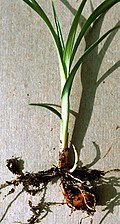Cookbook:Tigernut
| A Wikibookian suggests that this book or chapter be merged into Cookbook:Tiger Nut. Please discuss whether or not this merge should happen on the discussion page. |
Cookbook | Recipes | Ingredients | Equipment | Techniques | Cookbook Disambiguation Pages | Ingredients

Tigernuts are not nuts, but edible tubers with a slightly sweet, nutty flavour compared to the more bitter tasting tuber of the "purple nutsedge". They are quite hard and are generally soaked in water before they can be eaten. They have various uses, in particular they are used in Spain to make horchata. They are sometimes known by their Spanish name, chufa. Other common names for these tubers are "earthalmond" and "yellow nutsedge".
The tubers were originally cultivated by the ancient Egyptians. Commercial production in Europe is almost exclusively in the Valencia region of Spain. West African countries such as Ghana and Nigeria are major producers for the domestic market.
Tiger nuts have excellent nutritional qualities with a fat composition similar to olive oil and a rich mineral content, especially phosphorus and potassium. Tiger nuts are also gluten and cholesterol free, and have a very low sodium content.
According to the Consejo Regulador de Chufa de Valencia (Regulating Council for Valencia's Tigernuts)[1], the nutritional composition/100 ml of a classical Horchata de Chufas, or Orxata de Xufes in Valencian language, is as follows: energy content around 66 kcal, proteins around 0.5 g, carbohydrates over 10 g with starch at least 1.9 g, fats at least 2 g.
